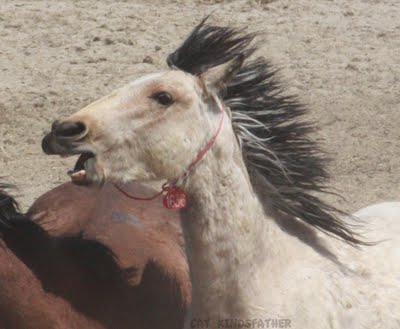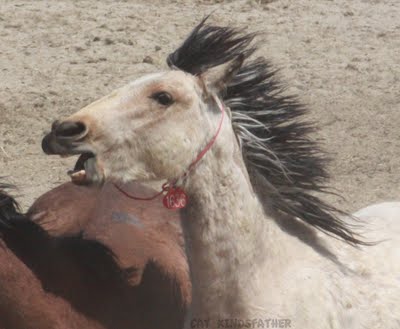
Latest Instagram Photos
       
|
|
|
|
|

Sunday, April 25, 2010
Still, I Am Wild  photo by Cat Kindsfather Dear Readers, Prehistoric power like that exploding from this young stallion is a rare sight in modern America. We see physical violence -- shootings on TV, a wrecking ball spraying bricks from an old building, fly-overs dropping death on a village, but not the short-fuse power of a stallion protesting some kind of trespass. The mystery of a creature so powerful, yet protective, thrills us. It's part of what's helped wild horses to survive. And it's part of what BLM has stolen and will continue to steal from us tomorrow, and the next day. Already hundreds of Calico stallions have been spooked into a squeeze chute and shot up with anesthetic and paralytic drugs. Then, they're released. Bursting free of confinement, they gallop a few strides before the drugs take hold. Then, the stallions collapse. Conscious, but unable to move, they are subjected to surgery. Perhaps it doesn't hurt, as we were told, but a wild stallion will run, when he's beaten. And these stallions must know this fight is stacked against them. This is a fight he can't win. Neither can he run. He must lie motionless during 4-10 minutes of irreversible castration. Take a second look at this horse.  Even collared by man's designation of his identity, this horse knows who he is, what he must do. But he has not yet been gelded. Yesterday, a staffer said BLM has a "reasonable expectation" that these Calico geldings will be adopted. Never mind the thousands of geldings grazing like cattle in long-term holding, far from their rangeland homes. I hope BLM is right. I hope we swap partnership for what we've allowed to be stolen. I really do. Terri Permalink to this blog post Posted by Terri Farley @ 9:29 AM Comments: Funny how they are spending more money to "kill" the natural instincts of the stallions by gelding them, instead of finding a way to place the ones they already have that are so called "adoptable" geldings. If gelding them would make them adoptable - we wouldn't have umpteen thousand geldings that are standing in holding pens unadopted. There are simply way too many in holding pens that need homes. It would be different if they were going to re-release them as gelding bands. Then it would make morse sense. But to put them through that when they are most likely going to end up at slaughter anyway just causes extra pain for no reason. After a wild stallion is gelded, it has to be forced to run and exercise about 20-25 minutes a day so the swelling and fluids that have gathered in the wound are forced down. They don't want to run because they are sore, so they have to be chased with either a vehicle or someone on horseback. When gelding is done so a horse can be adopted or released in a gelding band, there is a means to an end and they have a good life so it is okay that they go through the stress and pain. But to do it for no good reason is ridiculous and cruel. As long as the stallions are not fighting over mares, they will interact pretty much the same as they will after they are gelded. They are not magically all going to "get along" because they have been gelded. I worked at a sanctuary and was directly involved with the gelding process. These horses were then released as gelding bands. We did it as calmly and humanely as possible, but the older ones did experience some discomfort. On an interesting note though, the youngsters just jumped up and started eating like nothing ever happened. I pray every day that we can do more for these beautiful animals. I also thank God that there are people like Terri who never stop the fight. Love you Girl. Palomino & Chilly Pepper Hi, I'm writing from Portugal and i have had a little experience with the wild garrano pony herds up in the hills above my house. The breed book was opened for ten years to improve the breed and when it closed there were a lot of owners left with ponies that were not excepted into the breed book. These ponies are used to running unsupervised in the hills and while the breeding book was opened, they were caught and vetted every year. But now the owners have to do it and they don't want to spend the money on these "worthless, unpapered" ponies. They are sometimes sold for children to use, but more often just used for meat. There are two Japanese scientists from the U of Tokyo doing a government subsidized bahavior study of a couple of groups of these ponies and some of the owners have formed an association to use the ponies for hypotherapy for what used to be termed "handicapped" children. I just wondered if you know what happened to these geldings you wrote about? Post a Comment |
|
|
Home | Books | The Author | Connect | Education | Wild Horses © Terri Farley |




